Description
Instruction for medical use
of DIFLUCAN medicine *
Trade name
Diflucan *
International unlicensed
name Flukonazol Lekarstvennaya form
of the Capsule of 50 mg, 150 mg.
Solution for intravenous administration 2mg/ml – 50 ml.
Structure
of the Capsule
One capsule contains
active agent – flukonazol 50, 150 mg,
excipients: lactose, corn starch, silicon dioxide colloidal, magnesium stearate, sodium lauryl sulfate
structure of a cover: the titan dioxide (E171), gelatin, blue dye (E 131), blackened *
* contain iron oxide black (E 172), shellac, industrial metilirovanny alcohol, butyl alcohol, isopropyl alcohol, propylene glycol, water purified.
Solution for intravenous administration
of 1 ml of solution contains
active agent – flukonazol 2 mg,
excipients: sodium chloride, water for injections.
Description
of the Capsule of 50 mg: biryuzovo / white capsules No. 4 with marking of Pfizer and FLU-50.
Capsules of 150 mg: turquoise capsules No. 1 with marking of Pfizer and FLU-150.
Contents of capsules: powder of almost white color.
Solution for intravenous administration: transparent colourless solution.
Pharmacotherapeutic group
Antifungal drugs for system use.
Triazole derivatives.
The code of automatic telephone exchange J02AC01
the Pharmacological
Pharmacokinetics Later properties of intake Diflucan is well soaked up, the general bioavailability – 90%. The concomitant use of food does not influence absorption of drug at intake. Concentration in plasma reaches peak in 0.5-1.5 h after intake of Diflucan on an empty stomach, and elimination half-life makes about 30 h. Concentration in plasma is proportional to a dose. 90% of equilibrium concentration are reached by 4-5th day after the beginning of therapy (at multiple dose of drug once a day).
Linking with proteins – low (11-12%). Diflucan well gets into all fluid mediums of an organism.
Drug is removed, generally by kidneys, about 80% of the entered dose are found in urine in not changed look. The clearance of Diflucan is proportional to clearance of creatinine. The circulating metabolites are not found.
The pharmacodynamics
Diflucan, triazolny antifungal means, is powerful selection inhibitor of synthesis of sterols in a cell of mushrooms.
Diflucan shows activity in the infections caused:
– Candida spp., including generalized candidiasis
– Cryptococcus neoformans, including intracranial infections
– Microsporum spp.
– Trychophyton spp.
– Blastomyces dermatitides
– Coccidioides immitis
– Histoplasma capsulatum
Diflucan has high specificity concerning the fungal enzymes dependent on cytochrome P – 450.
Indications
– a cryptococcosis, including cryptococcal meningitis and infections of other localization (for example, lungs, skin), including. at patients with the normal immune response and patients with AIDS, recipients of transplanted organs and patients with other forms of an immunodeficiency, maintenance therapy for the purpose of prevention of a recurrence of a cryptococcosis at patients with AIDS
– generalized candidiasis, including a kandidemiya, disseminate candidiasis and other forms of an invasive candidosis infection, such as infections of a peritoneum, endocardium, eyes, respiratory and uric ways, including at the patients with malignant tumors who are in intensive care units and receiving cytotoxic or immunosuppressive means and also at patients with other factors contributing ment of candidiasis
– candidiasis of mucous membranes, including mucous mouth and throat, a gullet, noninvasive bronchopulmonary infections, a kandiduriya, the skin and mucous and chronic atrophic candidiasis of an oral cavity (connected with carrying dentures), including at patients with normal and suppressed immune function, prevention of a recurrence of oropharyngeal candidiasis at patients with AIDS
– genital candidiasis, acute or recurrent vaginal candidiasis, prevention for the purpose of reduction of frequency of a recurrence of vaginal candidiasis (3 and more episodes a year), a candidosis balanitis
– prevention of fungal infections at the patients with malignant tumors predisposed to such infections as a result of cytotoxic chemotherapy or radiation therapy
– skin mycoses, including mycoses of feet, bodies, inguinal area, a chromophytosis, an onychomycosis and skin candidosis infections
– deep endemic mycoses at patients with normal immunity, a coccidioidosis, a paracoccidioidosis, a sporotrichosis and histoplasmosis.
Route of administration and doses
of the Capsule inside. Capsules are swallowed entirely.
Solution for intravenous administration – intravenous infusions.
Therapy can be begun before obtaining results of crops and other laboratory researches. However anti-infectious therapy needs to be changed as appropriate when results of these researches become known.
Diflucan can be accepted inside or to enter intravenously by infusion with a speed no more than 10 ml/min. The choice of a method of administration depends on a clinical condition of the patient. When translating the patient from drug of change of a daily dose, intravenous on oral administration, it is not required.
The daily dose of Diflucan depends on character and weight of a fungal infection.
Use for adults
1. In cryptococcal meningitis and cryptococcal infections of other localization in the first day usually appoint 400 mg, and then continue treatment in a dose of 200-400 mg once a day. Duration of treatment of cryptococcal infections depends on presence of clinical and mycologic effect, in cryptococcal meningitis the treatment is usually continued at least by 6-8 weeks.
The recommended Diflucan dosage for prevention of a recurrence of cryptococcal meningitis at patients with AIDS of 200 mg/days
2. At a kandidemiya, disseminate candidiasis and other invasive candidosis infections the dose usually makes 400 mg in the first day, then on 200 mg/days. Depending on expressiveness of clinical effect the dose can be increased up to 400 mg/days.
Duration of therapy depends on clinical and mycologic effect.
3. In oropharyngeal candidiasis in the first day drug is usually appointed on 200 mg, then continue 100 mg once a day. Treatment is continued within 2 weeks to reduce recurrence probability.
In the atrophic oral candidiasis connected with carrying dentures, drug usually appoint in a dose 50 mg within 14 days in combination with local antiseptics for processing of a prosthesis once a day.
In other candidosis infections of mucous membranes (except for genital candidiasis, see below), for example, an esophagitis, noninvasive bronchopulmonary infections, a kandiduriya, skin candidiasis, the effective dose usually makes 50-100 mg/days lasting treatment of 14-30 days.
For prevention of a recurrence of oropharyngeal candidiasis at patients with AIDS after end of a full course of primary therapy Diflucan can be appointed on 150 mg once a week.
4. In vaginal candidiasis Diflucan is appointed once inside in a dose of 150 mg. For prevention of vaginal candidiasis it is possible to use drug in a dose 150 mg once a month. Duration of therapy is determined individually, it varies from 4 to 12 months.
In a candidosis balanitis Diflucan is appointed once in a dose of 150 mg inside.
5. For prevention of fungal infections at patients with malignant tumors the recommended dose of Diflucan makes 50-400 mg depending on degree of risk of developing a fungal infection once a day. For patients with high risk of a generalized infection, for example, from expressed or it is long the remaining neutropenia, the recommended dose makes 400 mg once a day.
6. In skin mycoses, including mycoses of feet, smooth skin, inguinal area, the recommended dose makes 150 mg once a week or 50 mg once a day. Therapy duration usually is 2-4 weeks, however in mycoses of feet longer therapy can be required (up to 6 weeks).
In a chromophytosis the recommended dose makes 300 mg once a week within 2 weeks, some patients need the third dose of 300 mg a week while for some patients it is accorded rather single welcome of 300-400 mg. The alternative scheme of treatment is use of drug on 50 mg within 2-4 weeks once a day.
In an onychomycosis the recommended dose makes 150 mg once a week. Treatment should be continued before full emergence of a healthy nail plate. Repeated growth of nails on fingers of hands and feet usually requires 3-6 months and 6-12 months according to. However, growth rate can vary over a wide range at different people and also depending on age. After successful treatment it is long the remaining persistent infections sometimes change of a shape of nails is observed.
7. In deep endemic mycoses the use of drug in a dose of 200-400 mg/days can be required. Duration of therapy is determined individually.
Use for children
As well as in similar infections at adults, duration of treatment depends on clinical and mycologic effect.
In candidiasis of mucous membranes the recommended dose of Diflucan makes 3 mg/kg/days. In the first day for the purpose of faster achievement of constant equilibrium concentration the shock dose of 6 mg/kg can be appointed.
For treatment of generalized candidiasis and a cryptococcal infection the recommended dose makes 6-12 mg/kg/days depending on disease severity.
For prevention of fungal infections at patients with malignant tumors at which risk of developing an infection is connected with the neutropenia developing as a result of cytotoxic chemotherapy or radiation therapy drug is appointed on 3-12 mg/kg/days depending on expressiveness and duration of preservation of the induced neutropenia.
Use for children at the age of 4 weeks and less
At newborns Diflucan is removed slowly. In the first 2 weeks of life, drug is appointed in the same dose, as to the senior children, but with an interval of 72 h. To children at the age of 3 and 4 weeks the same dose is entered with an interval of 48 h.
Use for elderly people
in the absence of symptoms of a renal failure drug is appointed in a usual dose.
Use for patients with a renal failure
At single dose of change of a dose is not required. At patients with a renal failure at repeated use of drug it is necessary to enter originally a shock dose from 50 mg to 400 mg then the daily dose (depending on the indication) is established according to the following table:
Clearance of creatinine (ml/min.)
Percent of the recommended dose
>
50 ≤50 (without dialysis)
Regular dialysis
of 100%
of 50%
of 100% after each dialysis
Side effects
– a headache, dizziness, spasms, change of taste
– nausea, vomiting, an abdominal pain, a meteorism, diarrhea, dyspepsia
– hepatotoxicity, including exceptional cases with a lethal outcome
– increase in level of alkaline phosphatase, bilirubin, serumal level of aminotransferases (ALT and nuclear heating plant), increase in level of cholesterol and triglycerides in plasma, a hypopotassemia
– an abnormal liver function, hepatitis, hepatocellular necrosis, jaundice
– rash, an alopecia, exfoliative skin diseases, including Stephens’s syndrome – Johnson and a toxic necrolysis of epidermis
– a leukopenia, including a neutropenia and an agranulocytosis, thrombocytopenia
– an anaphylaxis (including a Quincke’s disease, a face edema, urticaria, an itching)
– increase in an interval of QT at the ECG, blinking/trembling of ventricles
At patients with AIDS or cancer, at treatment by Diflucan and similar drugs was observed changes of indicators of blood, function of kidneys and a liver, however the clinical value of these changes and their communication with treatment are not established.
Contraindications
– hypersensitivity to a flukonazol, other components
of drug or azolny substances with similar to a flukonazol structure
– a concomitant use of a terfenadin during repeated use
of Diflucan in a dose of 400 mg/days and more
– simultaneous use of a tsizaprid
– pregnancy and a lactation
With care
Disturbance of indicators of function of a liver against the background of use of a flukonazol, appearance of rash against the background of use of a flukonazol for patients with a superficial fungal infection and invasive/system fungal infections, simultaneous use of a terfenadin and flukonazol in a dose less than 400 mg/days, potentially pro-arrhythmic states at patients with multiple factors of risk (organic heart diseases, disturbances of electrolytic balance and the accompanying therapy contributing to the development of similar disturbances).
Medicinal interactions
Diflucan at simultaneous use with warfarin, increases a prothrombin time (by 12%) in this connection development of bleedings is possible (hematomas, bleedings from a nose and digestive tract, a hamaturia, a melena). At the patients receiving coumarinic anticoagulants it is necessary to control a prothrombin time constantly.
At simultaneous use in Diflucan with azithromycin of the significant pharmacokinetic interaction between both drugs it is not established.
Benzodiazepines (short action): after midazolam intake, Diflucan significantly increases concentration of midazolam and psychomotor effects, and this influence is more significant after reception of a flukonazol inside, than at its use intravenously. In need of the accompanying therapy by benzodiazepines of the patients accepting Diflucan it is necessary to observe for the purpose of a possible dose decline of benzodiazepine.
At patients with a transplantirovanny kidney, use of Diflucan in a dose of 200 mg/days leads to slow increase in concentration of cyclosporine. However, at multiple dose of Diflucan in a dose of 100 mg/days of change of concentration of cyclosporine at recipients of marrow it was not observed. At simultaneous use of a flukonazol and cyclosporine it is recommended to monitorirovat concentration of cyclosporine in blood.
Repeated use of Hydrochlorthiazidum along with Diflucan leads to increase in concentration of Diflucan in plasma for 40%. The effect of such degree of manifestation does not demand change of the mode of dosing of Diflucan from the patients receiving at the same time diuretics.
At simultaneous use of the combined oral contraceptives with Diflucan in a dose of 50 mg of significant effect on the level of hormones it is not established.
Simultaneous use of Diflucan and Phenytoinum can be followed by clinically significant increase in concentration of Phenytoinum. In case of need simultaneous use of both drugs, it is necessary to control concentration of Phenytoinum and as appropriate to correct its dose for the purpose of ensuring therapeutic concentration in serum.
Simultaneous use of Diflucan and a rifabutin can lead to increase in serumal concentration of the last. At simultaneous use of Diflucan and a rifabutin, uveitis cases are described. The patients who are at the same time receiving rifabutin and Diflucan, it is necessary to observe carefully.
At the patients who are at the same time accepting rifampicin and Diflucan it is necessary to consider expediency of increase in a dose of Diflucan.
The concomitant use of oral drugs of sulphonylurea and Diflucan leads to increase in elimination half-life of drugs of sulphonylurea (chlorpropamide, glibenclamide, a glipizid and tolbutamide). Sick diabetes it is possible to appoint combined use of Diflucan and drugs of sulphonylurea, but at the same time it is necessary to consider a possibility of development of a hypoglycemia.
Simultaneous use of Diflucan and a takrolimus leads to increase in serumal concentration of the last. Nephrotoxicity cases are described. The patients who are at the same time accepting takrolimus and Diflucan, it is necessary to observe carefully.
At simultaneous use of azolny antifungal means and a terfenadina developing of serious arrhythmias as a result of increase in an interval of QT is possible. At intake of Diflucan in a dose of 200 mg/days of increase in an interval of QT it is not established, however, use of Diflucan in doses of 400 mg/days and causes significant increase in concentration of a terfenadin in plasma above. The concomitant use of Diflucan in doses of 400 mg/days and more with terfenadiny is contraindicated. Treatment by Diflucan in doses less than 400 mg/days in combination with terfenadiny should be carried out under careful control.
Simultaneous use of Diflucan and theophylline leads to increase in serumal concentration of the last. When prescribing Diflucan the patients accepting theophylline in high doses need to control concentration of theophylline and, if necessary, to correct therapy as appropriate.
At simultaneous use of a zidovudine with Diflucan the increase in concentration of a zidovudine which is caused by decrease in metabolism of the last is noted. The patients receiving such combination should be observed for the purpose of identification of side effects of a zidovudine.
Simultaneous use of Diflucan with astemizoly or other drugs which metabolism is carried out by the system of P450 cytochrome can be followed by increase in serumal concentration of these means. Patients should be observed carefully.
Single or multiple dose of Diflucan in a dose of 50 mg does not influence metabolism of antipyrine at their concomitant use.
The listed interactions are established at repeated use of Diflucan, interactions with medicines as a result of single dose of Diflucan are unknown.
Diflucan for intravenous administration is compatible to the following solutions:
– 20% glucose solution
– Ringera solution
– Hartmann’s solution
– chloride potassium solution in glucose
– 4.2% bicarbonate sodium solution
– aminofuzin
– isotonic normal saline solution.
Diflucan can be entered into an infusional system together with one of the listed above solutions. It is not recommended to mix it with other drugs.
Special instructions
In rare instances use of Diflucan was followed by toxic changes of a liver, including with a lethal outcome, mainly at patients with associated diseases. Hepatotoxic action of Diflucan usually was reversible, its signs disappeared after the therapy termination. Patients at whom during treatment Diflucan breaks indicators of function of a liver need to be observed for the purpose of identification of signs of damage of a liver. At emergence of clinical signs or symptoms of damage of a liver which can be connected with Diflucan use, drug should be cancelled.
Diflucan in rare instances can cause anaphylactic reactions.
During treatment by Diflucan at patients exfoliative skin reactions, such as Stephens-Johnson’s syndrome and toxic epidermal necrolysis in rare instances developed. Patients with AIDS are more inclined ment of heavy skin reactions at use of many drugs. At emergence in the patient during treatment of a superficial fungal infection of rash which can be connected with Diflucan use, drug should be cancelled. At appearance of rash in patients with their invasive/system fungal infections it is necessary to observe and cancel carefully Diflucan at emergence of bullous defeats or a mnogoformny erythema.
Diflucan can cause increase in an interval of QT at the ECG. At Diflucan use the increase in an interval of QT and blinking/trembling of ventricles noted very seldom at patients with multiple factors of risk, such as organic heart diseases, disturbances of electrolytic balance and the accompanying therapy contributing to the development of similar disturbances. Therefore such patients with potentially pro-arrhythmic states should apply Diflucan with care.
Patients with diseases of a liver, heart and kidneys before use of Diflucan are recommended to consult with the doctor. At use of Diflucan of 150 mg concerning vaginal candidiasis the patients have to be warned that improvement of symptoms is usually observed in 24 h, but their total disappearance sometimes requires several days. At preservation of symptoms within several days, it is necessary to see a doctor.
The feature of influence of medicine on ability to run the vehicle or potentially dangerous mechanisms
Should be careful when driving or using of the equipment.
Overdose
Symptoms – strengthening of side effects.
Treatment – symptomatic (including the supporting measures and gastric lavage).
Diflucan is removed, generally with urine therefore the artificial diuresis can accelerate drug removal.
The session of a hemodialysis lasting 3 h reduces Diflucan level in plasma approximately by 50%.
The form of release and packing
of the Capsule of 50 mg on 7 capsules in blister strip packaging, on 1 or 4 blister strip packagings together with the instruction for use place in a cardboard pack.
Capsules of 150 mg on 1 capsule in blister strip packaging on 1 blister strip packaging together with the instruction for use place in a cardboard pack.
Solution for intravenous administration of 2 mg/ml 50 ml in a bottle from transparent colourless glass. The bottle is hermetically corked by a rubber bung and pressed out by an aluminum cap with a plastic insert. The bottle is supplied by the plastic holder fastening at the bottom of a bottle. On 1 bottle together with the instruction for use place in a cardboard pack.
Storage conditions
to Store capsules at a temperature not above 30 °C.
To store solution for intravenous administration at a temperature not above 30 °C. Not to allow freezing.
To store out of children’s reach!
Not to use a period of storage of 5 years after the expiration date specified on packing.
Prescription status
According to the prescription
PGM Pfizer Producer
of Sohn Industriale – the 20th reception des Indastriyes
37530 Potse Sur Tsisse France
* Torgovaya marka Pfizer Ink, New York, the USA
The director
of the Pharmacological Center R.S. Kuzdenbayeva.
Scientific secretary B.S. Kurmanova.
The expert / /
Is APPROVED
by the Order of the Chairman of the Committee of pharmaceutical control
of the Ministry of Health
of the Republic of Kazakhstan
from _____ ____________ 200 ___
No. ___________
IInstruktsiya on medical use
of DIFLUCAN medicine *
the Trade name
Diflucan *
the International unlicensed
name Flukonazol Lekarstvennaya a form
of the Capsule of 50 mg, 150 mg.
Solution for intravenous administration 2mg/ml – 50 ml.
Structure
of the Capsule
One capsule contains
active agent – flukonazol 50, 150 mg,
excipients: lactose, corn starch, silicon dioxide colloidal, magnesium stearate, sodium lauryl sulfate
structure of a cover: the titan dioxide (E171), gelatin, blue dye (E 131), blackened *
* contain iron oxide black (E 172), shellac, industrial metilirovanny alcohol, butyl alcohol, isopropyl alcohol, propylene glycol, water purified.
Solution for intravenous administration
of 1 ml of solution contains
active agent – flukonazol 2 mg,
excipients: sodium chloride, water for injections.
Description
of the Capsule of 50 mg: biryuzovo / white capsules No. 4 with marking of Pfizer and FLU-50.
Capsules of 150 mg: turquoise capsules No. 1 with marking of Pfizer and FLU-150.
Contents of capsules: powder of almost white color.
Solution for intravenous administration: transparent colourless solution.
Pharmacotherapeutic group
Antifungal drugs for system use.
Triazole derivatives.
The code of automatic telephone exchange J02AC01
the Pharmacological
Pharmacokinetics Later properties of intake Diflucan is well soaked up, the general bioavailability – 90%. The concomitant use of food does not influence absorption of drug at intake. Concentration in plasma reaches peak in 0.5-1.5 h after intake of Diflucan on an empty stomach, and elimination half-life makes about 30 h. Concentration in plasma is proportional to a dose. 90% of equilibrium concentration are reached by 4-5th day after the beginning of therapy (at multiple dose of drug once a day).
Linking with proteins – low (11-12%). Diflucan well gets into all fluid mediums of an organism.
Drug is removed, generally by kidneys, about 80% of the entered dose are found in urine in not changed look. The clearance of Diflucan is proportional to clearance of creatinine. The circulating metabolites are not found.
The pharmacodynamics
Diflucan, triazolny antifungal means, is powerful selection inhibitor of synthesis of sterols in a cell of mushrooms.
Diflucan shows activity in the infections caused:
– Candida spp., including generalized candidiasis
– Cryptococcus neoformans, including intracranial infections
– Microsporum spp.
– Trychophyton spp.
– Blastomyces dermatitides
– Coccidioides immitis
– Histoplasma capsulatum
Diflucan has high specificity concerning the fungal enzymes dependent on cytochrome P – 450.
Indications
– a cryptococcosis, including cryptococcal meningitis and infections of other localization (for example, lungs, skin), including. at patients with the normal immune response and patients with AIDS, recipients of transplanted organs and patients with other forms of an immunodeficiency, maintenance therapy for the purpose of prevention of a recurrence of a cryptococcosis at patients with AIDS
– generalized candidiasis, including a kandidemiya, disseminate candidiasis and other forms of an invasive candidosis infection, such as infections of a peritoneum, endocardium, eyes, respiratory and uric ways, including at the patients with malignant tumors who are in intensive care units and receiving cytotoxic or immunosuppressive means and also at patients with other factors contributing ment of candidiasis
– candidiasis of mucous membranes, including mucous mouth and throat, a gullet, noninvasive bronchopulmonary infections, a kandiduriya, the skin and mucous and chronic atrophic candidiasis of an oral cavity (connected with carrying dentures), including at patients with normal and suppressed immune function, prevention of a recurrence of oropharyngeal candidiasis at patients with AIDS
– genital candidiasis, acute or recurrent vaginal candidiasis, prevention for the purpose of reduction of frequency of a recurrence of vaginal candidiasis (3 and more episodes a year), a candidosis balanitis
– prevention of fungal infections at the patients with malignant tumors predisposed to such infections as a result of cytotoxic chemotherapy or radiation therapy
– skin mycoses, including mycoses of feet, bodies, inguinal area, a chromophytosis, an onychomycosis and skin candidosis infections
– deep endemic mycoses at patients with normal immunity, a coccidioidosis, a paracoccidioidosis, a sporotrichosis and histoplasmosis.
Route of administration and doses
of the Capsule inside. Capsules are swallowed entirely.
Solution for intravenous administration – intravenous infusions.
Therapy can be begun before obtaining results of crops and other laboratory researches. However anti-infectious therapy needs to be changed as appropriate when results of these researches become known.
Diflucan can be accepted inside or to enter intravenously by infusion with a speed no more than 10 ml/min. The choice of a method of administration depends on a clinical condition of the patient. When translating the patient from drug of change of a daily dose, intravenous on oral administration, it is not required.
The daily dose of Diflucan depends on character and weight of a fungal infection.
Use for adults
1. In cryptococcal meningitis and cryptococcal infections of other localization in the first day usually appoint 400 mg, and then continue treatment in a dose of 200-400 mg once a day. Duration of treatment of cryptococcal infections depends on presence of clinical and mycologic effect, in cryptococcal meningitis the treatment is usually continued at least by 6-8 weeks.
The recommended Diflucan dosage for prevention of a recurrence of cryptococcal meningitis at patients with AIDS of 200 mg/days
2. At a kandidemiya, disseminate candidiasis and other invasive candidosis infections the dose usually makes 400 mg in the first day, then on 200 mg/days. Depending on expressiveness of clinical effect the dose can be increased up to 400 mg/days.
Duration of therapy depends on clinical and mycologic effect.
3. In oropharyngeal candidiasis in the first day drug is usually appointed on 200 mg, then continue 100 mg once a day. Treatment is continued within 2 weeks to reduce recurrence probability.
In the atrophic oral candidiasis connected with carrying dentures, drug usually appoint in a dose 50 mg within 14 days in combination with local antiseptics for processing of a prosthesis once a day.
In other candidosis infections of mucous membranes (except for genital candidiasis, see below), for example, an esophagitis, noninvasive bronchopulmonary infections, a kandiduriya, skin candidiasis, the effective dose usually makes 50-100 mg/days lasting treatment of 14-30 days.
For prevention of a recurrence of oropharyngeal candidiasis at patients with AIDS after end of a full course of primary therapy Diflucan can be appointed on 150 mg once a week.
4. In vaginal candidiasis Diflucan is appointed once inside in a dose of 150 mg. For prevention of vaginal candidiasis it is possible to use drug in a dose 150 mg once a month. Duration of therapy is determined individually, it varies from 4 to 12 months.
In a candidosis balanitis Diflucan is appointed once in a dose of 150 mg inside.
5. For prevention of fungal infections at patients with malignant tumors the recommended dose of Diflucan makes 50-400 mg depending on degree of risk of developing a fungal infection once a day. For patients with high risk of a generalized infection, for example, from expressed or it is long the remaining neutropenia, the recommended dose makes 400 mg once a day.
6. In skin mycoses, including mycoses of feet, smooth skin, inguinal area, the recommended dose makes 150 mg once a week or 50 mg once a day. Therapy duration usually is 2-4 weeks, however in mycoses of feet longer therapy can be required (up to 6 weeks).
In a chromophytosis the recommended dose makes 300 mg once a week within 2 weeks, some patients need the third dose of 300 mg a week while for some patients it is accorded rather single welcome of 300-400 mg. The alternative scheme of treatment is use of drug on 50 mg within 2-4 weeks once a day.
In an onychomycosis the recommended dose makes 150 mg once a week. Treatment should be continued before full emergence of a healthy nail plate. Repeated growth of nails on fingers of hands and feet usually requires 3-6 months and 6-12 months according to. However, growth rate can vary over a wide range at different people and also depending on age. After successful treatment it is long the remaining persistent infections sometimes change of a shape of nails is observed.
7. In deep endemic mycoses the use of drug in a dose of 200-400 mg/days can be required. Duration of therapy is determined individually.
Use for children
As well as in similar infections at adults, duration of treatment depends on clinical and mycologic effect.
In candidiasis of mucous membranes the recommended dose of Diflucan makes 3 mg/kg/days. In the first day for the purpose of faster achievement of constant equilibrium concentration the shock dose of 6 mg/kg can be appointed.
For treatment of generalized candidiasis and a cryptococcal infection the recommended dose makes 6-12 mg/kg/days depending on disease severity.
For prevention of fungal infections at patients with malignant tumors at which risk of developing an infection is connected with the neutropenia developing as a result of cytotoxic chemotherapy or radiation therapy drug is appointed on 3-12 mg/kg/days depending on expressiveness and duration of preservation of the induced neutropenia.
Use for children at the age of 4 weeks and less
At newborns Diflucan is removed slowly. In the first 2 weeks of life, drug is appointed in the same dose, as to the senior children, but with an interval of 72 h. To children at the age of 3 and 4 weeks the same dose is entered with an interval of 48 h.
Use for elderly people
in the absence of symptoms of a renal failure drug is appointed in a usual dose.
Use for patients with a renal failure
At single dose of change of a dose is not required. At patients with a renal failure at repeated use of drug it is necessary to enter originally a shock dose from 50 mg to 400 mg then the daily dose (depending on the indication) is established according to the following table:
Clearance of creatinine (ml/min.)
Percent of the recommended dose
>
50 ≤50 (without dialysis)
Regular dialysis
of 100%
of 50%
of 100% after each dialysis
Side effects
– a headache, dizziness, spasms, change of tas
Additional information
| Ingredient |
|---|






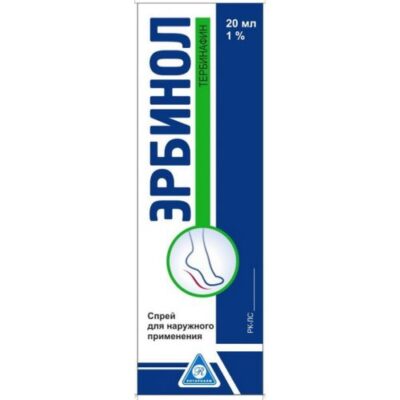
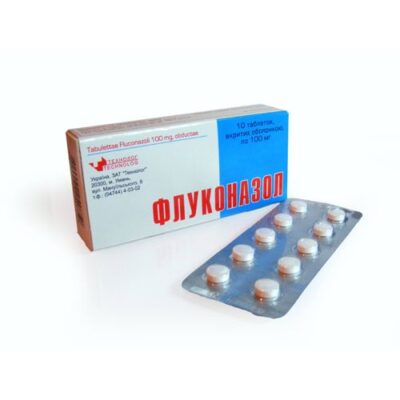
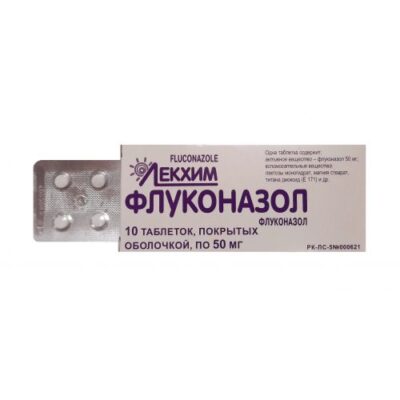
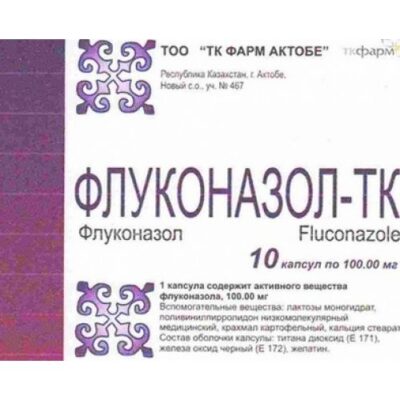
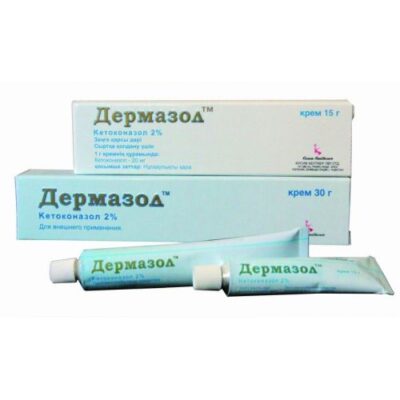
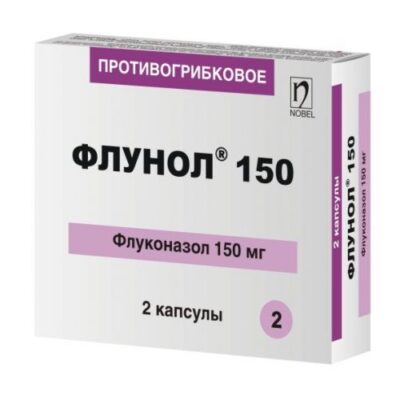
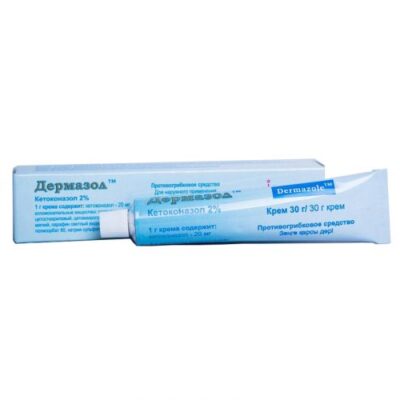
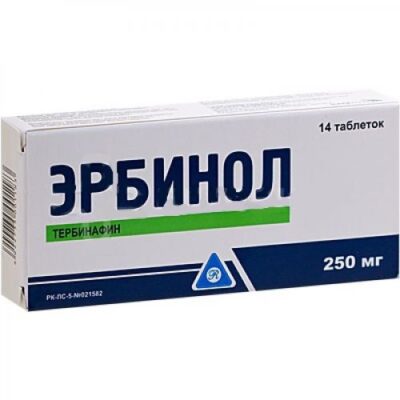
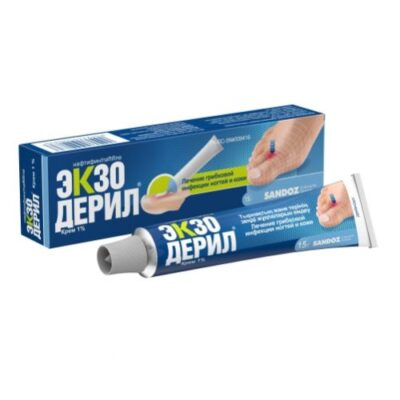
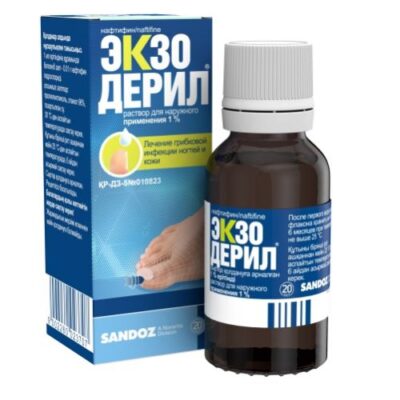






Reviews
There are no reviews yet.